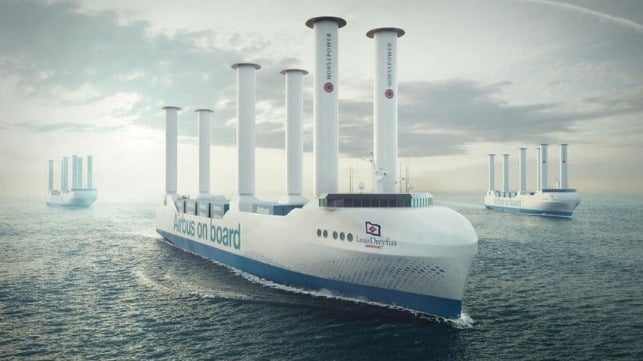Wind-Assisted Propulsion Due for Significant Growth Concludes LR Research

Wind-assisted propulsion is “on the verge of a tipping point,” concludes Lloyd’s Register in a newly released analysis of the market. The presentation points to the growing familiarity with the technology and the pressure from regulations and customers driving owners and operators toward the technology while also highlighting challenges that remain ahead to realize the perceived potential for wind-assisted propulsion.
In the next two to three years, they anticipate the industry will pass the 100 mark for installed vessels up from 29 vessels that installed the systems between 2018 and 2023. Using data from Clarksons, LR cites orders now on the books for 72 vessels with wind-assisted propulsion. However, they forecast this is just the start with a potential for well over 2,000 newbuilds and retrofits in the bulker sector and nearly 400 tankers by 2050, based on projections from CE Delft. LR writes that an analysis identifies a top-end potential for nearly 14,000 candidate vessels across all sectors of the industry over the next 26 years.
“Wind-assisted propulsion systems are increasingly being used by ship operators to reduce fuel consumption, meet energy efficiency regulations, and minimize exposure to carbon costs,” says Dr. Santiago Suarez de la Fuente, LR’s Ship Performance Manager. “LR’s new research report demonstrates that there is growing confidence in the available solutions.”
The report examines issues ranging from costs and compliance drivers to the different technologies and the current capacity for supply and installation. They conclude that wind-assisted propulsion systems are in their “late childhood” and due for a significant growth spurt.
Gavin Allwright, Secretary of the International Windship Association agrees pointing to what he calls “a perfect storm brewing.” He points to new regulations, price challenges with existing and new fuels, and cargo owners’ pressures to reduce scope three emissions.
To date, they note the strong adoption is coming in the bulker sector followed by the first introductions on tankers and with cargo Ro/Ros. While they project that demand will remain strong from bulkers, they expect tankers will also increase adoption and they note the first orders for installations on LNG and LPG gas carriers and car carriers reflect the increasing and broadening uptake of wind power.
The report highlights that the first adoptions have come from rotors and expects that the Flettner technology will continue to see demand. However, they also note the rise in suction wings as well as rigid sails while projecting that demand for kite sails will lag behind the other technologies.
Optimistic forecasts they note project that 15 percent of the global fleet could move to wind-assisted propulsion. LR however also points to a range of obstacles to achieving these forecasts. While they believe owners and operators are becoming more comfortable with the technology, they note uncertainty remains around the actual fuel savings. LR writes the problem is a lack of standardized criteria for validating the savings claims.
They also point to a need for a wider base of shipyards with installation capabilities as well as an increase in the supply chain for the technology. LR highlights that only around 16 yards have carried out wind-assisted propulsion retrofits. To meet the forecasts, they note would require a 75-fold increase in the number of units delivered in the past five years.
They note that there are still concerns about potential hidden costs that could come from the required engineering work as well as operational costs. While they think this is contributing to uncertainty around the business case, LR believes that as the issues of validation and equipment availability are addressed, adoption of the technologies will accelerate.
